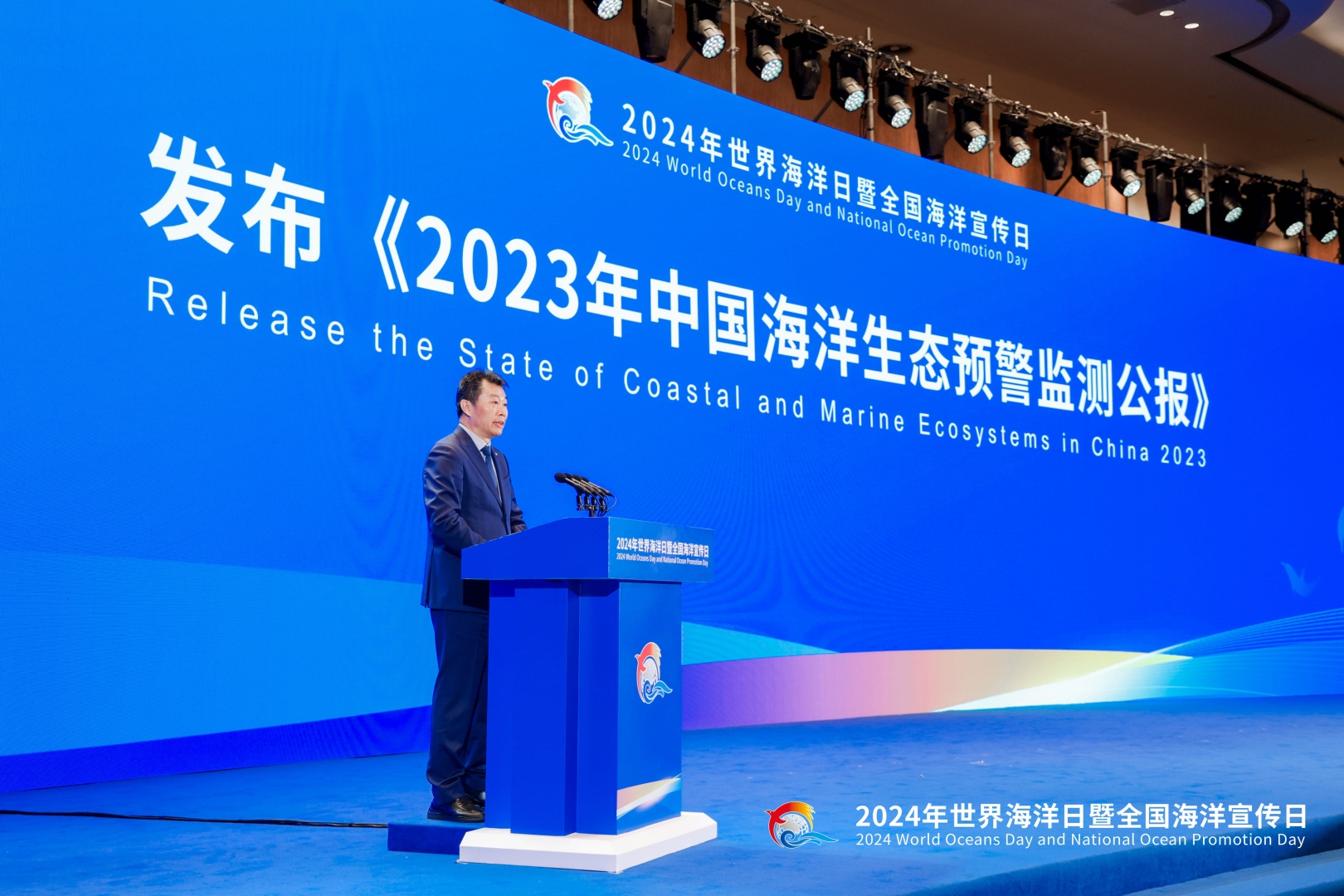The State of Coastal and Marine Ecosystems in China 2023
Thursday, 27 June 2024
(released on 8 June 2024)
China is located in the eastern Eurasian continent and the west of the Pacific. Its jurisdictional seas cover the temperate, subtropical, tropical climate zones, juxtaposed to the continent with a long coastline and decorated with diverse undersea landforms that are rich in marine biological resources such as coral reefs, seagrass beds, coastal salt marshes, mangrove swamps, estuaries, bays, islands and other ecosystems. They also provide critical habitats for some rare and endangered species such as Harbor Seals, Chinese White Dolphins and Bryde's Whales in the western Pacific Ocean, and key stopover sites along the East Asian-Australasian Flyway. These areas undoubtedly play significant roles in stabilizing the global marine ecological services.
In accordance with the Marine Environment Protection Law of the People’s Republic of China, the Ministry of Natural Resources (MNR) is responsible for monitoring and issuing early warning and bulletins of state of coastal and marine ecosystems. The MNR has established and operationalized an integrated marine ecosystem monitoring program functional on land, sea, atmosphere and space at the central and local levels so as to transform into concrete action the philosophy of ecological civilization. Status of typical coastal and marine ecosystems is surveyed and their ecological trends are monitored annually to comprehensively understand their ecological status. Warning signals are sent on red tides, green tides, coral bleaching, small-scale outbreaks of marine organisms and other ecological incidences.
The results from these monitoring efforts indicate that China's marine ecological status is generally stable in recent years, with signs of improvements in some areas and indications of a slowing trend in degradation of typical ecosystems.
The numerical values of salinity, dissolved oxygen, acidity and chemical oxygen demand of seawater in near-shore areas have not changed markedly, while the numerical values of inorganic nitrogen and active phosphate have declined. The number of species and diversity index of phytoplankton, zooplankton and macrobenthos remained generally stable. Under the influence of global warming, the sea surface temperature of China's inshore areas was 0.8°C higher than usual in the summer of 2023, reaching a higher level since observation.
Coral reefs, seagrass beds, coastal salt marshes and mangrove ecosystems are primarily in excellent condition.
Coral reefs are widely distributed in the coastal areas south of Dongshan County of Fujian Province, with observed large distributions in near-shore areas surrounding Hainan Island. Biodiversity is rich in reef ecosystems, with distribution of 40% of identified reef-building coral species in the world, and a recording of 600 species of reef fish. Live coral cover in each monitoring area generally increased in 2023 compared with 2019-2020, and the structure of the biological community remained stable. Coral bleaching was observed in a few monitoring sites due to rising temperature of seawater.
Seagrass beds are distributed in about 107 square kilometers of near-shore waters, with large contiguous area coverage in Xingcheng County (Liaoning Province), Caofeidian District (Tangshan City of Hebei Province), Zhanjiang City (Guangdong Province), and cities of Wenchang and Qionghai (Hainan Province). The overall seagrass cover in the monitoring areas increased in 2023 compared with 2020, along with suitable water environment and sedimentary conditions for seagrass growth.
Coastal salt marshes are mainly distributed in provinces of Jiangsu, Shandong, Zhejiang and Fujian, and the municipality of Shanghai, with a total area of around 1,132 square kilometers. In 2023, the vegetation of the salt marshes in each monitoring area was in healthy growth, the density of macrobenthos showed increase in comparison with that of 2020, and the sedimentary conditions were suitable for the growth of vegetation. Presently, invasion of Spartina alterniflora was the main ecological challenge.
China is one of the few countries in the world with a net increase in mangrove areas, with a total coverage of 292 square kilometers. The southernmost natural distribution of mangrove forests reaches Sanya City (Hainan Province), the northernmost natural distribution reaches Fuding City (Fujian Province), and some places in Zhejiang were artificially planted. In total, 27 dominant tree species are recorded, with highest number in species in Hainan Province. In 2023, the ecological status of mangrove forests in the monitoring areas was classified as excellent.
The ecological status of the three estuaries of the Yellow River, the Yangtze River and the Pearl River generally remains stable, with an increase in biodiversity and sound sedimentary conditions. The areas of eutrophication in the Yellow River estuary have decreased compared with last year, and the Yangtze Finless Porpoise as a wild animal species under national protection was repeatedly sighted at the Yangtze River estuary. Populations of the Chinese White Dolphin in the Pearl River estuary are either stable and viable.
The ecological conditions of the Laizhou Bay, the Jiaozhou Bay, the Xiangshan Harbor, the Yueqing Bay and the Daya Bay were generally stable, with improvements in water environment and the sedimentary conditions. The ecological status of these islands was stable and has shown signs of improvements, and 64.5% of the monitored islands are rated as healthy in conditions.
The monitoring results also show incidences of red tides, green tides, marine deoxygenation, coastal erosion and other disasters. In 2023, a total of 46 outbreaks of red tides were detected, the largest area covered by a single green tide in the Yellow Sea was 998 square kilometers. Five localized outbreaks of marine organisms were detected in the same year, and the coastal sea level rised 72 mm higher than normal years. Deoxygenation in estuaries and coastal erosion were more prevalent in some areas.
Authorities in charge of natural resources (coasts and seas) and forestry and grasslands at all levels have firmly engaged in translating the concept of giving priority to ecological integrity into actions. Spatial plans have been improved to guide sea uses, and some 150,000 square kilometers of sea are delineated and included in marine ecological protection redlines. The network of marine protected areas has been strengthened, protecting about 93,300 square kilometers of sea. Ecological conservation, restoration and comprehensive environmental restoration projects are being carried out, achieving the restoration and consolidation of nearly 1,680 kilometers of coastlines and over 750,000 mu (equivalent to 50,000 hectares) of coastal wetlands. Further efforts will be made to showcase Chinese solutions for improving global ocean governance through closer international cooperation and exchanges on marine ecological protection.
The Ministry of Natural Resources is committed to disseminating and replicating the of Xiamen Model in coastal conservation and restoration in our pursuit of the vision of achieving harmony between humankind and the sea.




